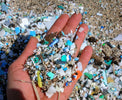
The Hidden Danger of Microplastics: How Ink Cartridge Waste Contributes to Pollution
, by Planet Green, 2 min reading time

, by Planet Green, 2 min reading time
Plastic waste is everywhere, from the depths of the ocean to the peaks of the highest mountains. But what many people don’t realize is that this pollution often starts small—microscopically small. Microplastics, tiny particles of plastic less than 5 millimeters in size, have become a global environmental crisis. And one surprising contributor to this problem? Discarded ink cartridges.
What Are Microplastics?
Microplastics are small plastic fragments that result from the breakdown of larger plastic items. Over time, exposure to sunlight, heat, and environmental forces causes plastics to fragment into smaller and smaller pieces. These microplastics are so tiny that they easily infiltrate ecosystems, contaminating soil, waterways, and even the food we eat.
Ink Cartridges and Microplastic Pollution
Each year, millions of ink cartridges are thrown away, many ending up in landfills. These cartridges are often made from durable plastics designed to withstand heavy use. While this durability might seem like a good thing, it becomes a problem when these plastics are left to degrade over hundreds of years.
As the cartridges break down, they release microplastics into the environment. Rainwater and soil erosion can carry these particles into streams, rivers, and eventually the ocean. There, they join the estimated 14 million tons of microplastics already polluting marine ecosystems.
The Ripple Effect: How Microplastics Impact Wildlife and Humans
Once in the environment, microplastics pose serious risks to wildlife and human health. Animals, mistaking these tiny particles for food, ingest them, leading to malnutrition, internal injuries, and even death. Through the food chain, these plastics make their way to humans, with studies finding microplastics in drinking water, salt, and seafood.
The long-term health effects of microplastic consumption in humans are still being studied, but early research suggests links to hormonal disruption, inflammation, and other health issues.
Solutions: Tackling the Problem at Its Source
The good news is that we can stop microplastic pollution before it starts by addressing the root of the problem—plastic waste. Recycling programs like those offered by Planet Green Recycle play a critical role in this effort.
Planet Green Recycle takes used ink cartridges and remanufactures them into high-quality products, diverting millions of cartridges from landfills annually. By extending the life cycle of these products, they prevent the breakdown of plastics into microplastics, protecting ecosystems and communities.
What You Can Do
Combatting microplastic pollution is a shared responsibility. Here are a few ways you can help:
A Cleaner Future is Possible
Microplastics are a global issue, but by taking small, meaningful steps, we can reduce their impact. Recycling ink cartridges is one simple way to make a big difference. Together, we can protect the environment, safeguard wildlife, and ensure a healthier future for generations to come.

When people talk about e-waste, the conversation usually centers on big-ticket items: cell phones, laptops, televisions, or kitchen appliances. But one of the most common...

Most people see a printer cartridge as a small, everyday item. But behind that small piece of plastic is a surprisingly large environmental cost. Every...

The phrase “circular economy” has become a buzzword in sustainability circles, but what does it really mean? In simple terms, it’s about designing products and...

For years, recycling ink cartridges often meant relying on office collection bins, retail drop-off points, or corporate programs tied to large accounts. But as more...